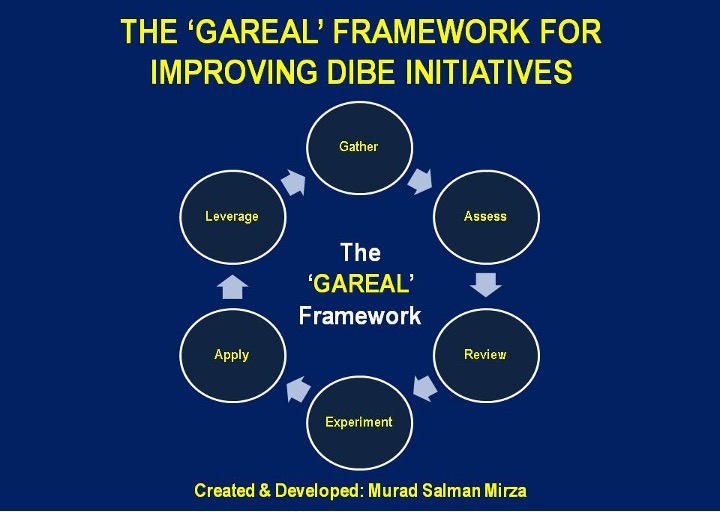The COVID-19 pandemic has been profoundly consequential in a multitude of ways across the corporate landscape. The emerging ‘new normal’ demands fresh thinking and innovative approaches for creating an optimum balance in the employment relationship that has been dealt crushing blows from the weakening of the psychological contracts. A key way to ‘heal’ the aforementioned ‘divide’ is to methodically scrutinize the ‘ingrained practices’ that have led ‘seemingly progressive’ organizations to the brink of corporate meltdowns. Consequently, the following framework is being presented to elucidate a viable pathway for improving the prevailing DIBE (Diversity, Inclusion, Belonging, and Equity) initiatives to strengthen the ‘jovial anchors’ for retaining the desired talent:

Gather
This refers to the deployment of formal and informal ways of getting data/information by assigned professionals, working with a senior management leader appointed by the top leadership within the corporate hierarchy about how well the current DIBE initiatives are faring in terms of meeting their relevant objectives. Some of the respective methods are:
- Examples of Formal Techniques
Employee Surveys, Focus Groups, Exit Interviews, Brainstorming Sessions, Performance Appraisal Meetings, Management Review Meetings, Union Grievance/Negotiation Meetings, HR Incidence/Disciplinary Reports, Industry/Competitor/Functional Benchmarking, Relevant Academic Research Review, etc.
- Examples of Informal Techniques
Mentor-Mentee Engagements, Corporate Social Events, Lunch Chats, Staff Bonding Excursions, Social Media Monitoring, Random Networking, Active Grapevine Monitoring, Employee Engagement Activities, Corporate Activities Volunteering, Informal Feedback (Family, Friends, Acquaintances, etc.), Open Q&A Forums with Senior Management, etc.
The date/information gained from the combination of the aforementioned examples of formal and informal methods should be reviewed by the designated senior management leader and, upon validation, forwarded to the specialized professionals within the organization.
Assess
This refers to the analysis of the data/information acquired from the ‘Gather’ stage by the specialized professionals with at least the following capabilities:
- Ability to assess data/information by utilizing appropriate tools and techniques
- Comprehensive knowledge of DIBE initiatives being run in the organization
- Ability to remain unbiased and nonjudgmental while assessing the data/information exhaustively, diligently, and judiciously
Consequently, the findings from the specialized professionals should be reviewed by the designated senior management leader, who, upon validation, should prepare a report for the top leadership to engage in an honest self-reflection and facilitate appropriate corrective actions to overcome any shortcomings or further improve existing practices that are deemed to be outdated due to the changing industry practices.
Review
This refers to the review of the report submitted by the designated senior management leader by the top leadership. The respective review should be done in the presence of all the relevant functional heads, who have already been provided with a copy of the report as part of the meeting agenda, and cover at least the following aspects:
- Confirming the fulfillment of the overall objectives for the whole data/information gathering and reportingthe exercise about improvement of DIBE initiatives
- Verification of the authenticity, impartiality, validity, feasibility, and robustness of the results/conclusions/recommendations provided in the report
- Authorizing organization-wide experimentation, with relevant human and other resources, of the recommendations for getting practical feedback for any subsequent adjustments before the ‘actual’ implementation
The minutes of the aforementioned review should be circulated among all the participants with appropriate timelines and responsibilities for actionable items. Tentative date for the next management review should also be included by allowing some ‘slack time’ for any unforeseen contingencies.
Experiment
This refers to applying recommendations in the report by the designated senior management leader and their team on an experimental basis by utilizing approved resources. It should be conducted in close collaboration with the relevant functional heads.
As a matter of good practice, employees should be informed of such initiatives in advance by the HR function that certain policies/procedures/practices are being conducted experimentally to assure/ensure their ‘on-ground’ efficacy. The assigned professionals carrying out the experimentation should have at least the following capabilities:
- Sound understanding of the report recommendations and their assigned role in the experimentation exercise
- Resourcefulness in getting desired help for experimentation from relevant personnel within the organization
- Strong writing skills to create a professional document relating to the findings of the experimental exercise that can be viewed and understood easily by the designated senior management leader
The results from the experimentation exercise should be compiled by the designated senior management leader and presented in the next scheduled review for appropriate scrutiny and the ‘finalization’ of ‘approved’ measures by the top leadership that the relevant functional heads can formally implement within the organization.
Apply
This refers to implementing the ‘approved’ measures throughout the organization by the relevant functional heads. Care needs to be taken that all the online or offline remnants of the previous policies need to be removed entirely from the pertinent operational areas and replaced with the new directives to avoid rampant confusion, unintentional errors or the chance of duplicity by the ‘disadvantaged’ segment of the workforce smoldering over the lost ‘unfairly privileged’ status.
A good way of assuring a prudent implementation of the ‘approved’ measures is to hold online or face-to-face Q&A forums with the employees to provide clear information, gain ‘ground’ support, and remove any ambiguities in intent and implementation. Such an initiative will also serve as an effective buffer against misinformation often floated through the grapevine.
It is critical that the relevant functional heads do consistent monitoring in terms of ensuring effective implementation of the ‘approved’ measures to achieve the overall objectives in unity with the strategic imperatives. One of the ways to boost the quality of monitoring can be by appointing trustworthy and capable ‘DIBE Ambassadors’ within the functions to act as ‘eyes and ears’ for the relevant functional heads, especially in terms of taking proactive actions in case of internal discord/discontent.
Leverage
This refers to the top leadership’s astute utilization of key stakeholders in promoting, cementing, and institutionalizing the implemented DIBE measures throughout the organization. Such an approach would entail creating a strong ‘buy-in’ from the influential members of the workforce, e.g., widely respected opinion leaders, union stalwarts, astute powerbrokers, etc., by upholding the principles of HITAR (Honesty, Integrity, Transparency, Accountability, and Reliability) as a ‘role model’ in the professional execution of relevant responsibilities and maintaining communication channels that can ‘bear’ constructive criticisms and forge robust partnerships.
Additionally, the vibrant ecosystem of the organization can also be productively engaged in the respective context, e.g., community leaders, industry regulators, citizen activists, corporate watchdogs, responsible competitors, professional associations, benchmarked organizations, best practice experts, organizational researchers, etc., in fruitfully achieving the desired goals of improving DIBE initiatives.
The framework above has been designed to facilitate progressive organizations in overcoming the challenges associated with managing a jittery workforce during turbulent economic times, akin to the COVID-19 pandemic. It is flexible in its application to any size and type of organization, yet, firm in its propounded guiding principles for achieving the desired ‘humanistic’ objectives. Will you commit?
Post Views: 1,684






